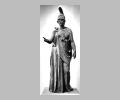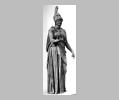
Piraeus Athena, from right (before restoration)

Piraeus Athena, frontal view (before restoration)

Piraeus Athena, from left (before restoration)
| Collection: | Piraeus Archaeological Museum |
| Title: | Piraeus Athena |
| Context: | Possibly from Delos |
| Findspot: | Excavated at Piraeus (found in 1959 in a cache together with the |
| Summary: | Standing helmeted Athena with diagonal aegis |
| Object Function: | Cult |
| Material: | Bronze |
| Sculpture Type: | Free-standing statue |
| Category: | Original/copies |
| Style: | Late Classical |
| Technique: | Hollow cast |
| Original or Copy: | Original |
| Date: | ca. 360 BC - ca. 340 BC |
| Dimensions: | H. 2.35 m |
| Scale: | Over life-size |
| Region: | Attica |
| Period: | Late Classical |
Subject Description:
The statue of Athena is apparently an original creation of the 4th century, which was buried as part of a cache of bronze statues following the sack of Athens by Sulla in 86 BC. The statue is nearly complete, except for part of the left foot and the attributes, and is particularly interesting for all the details which are preserved intact. The figure faces forward, the weight on the right leg, the left leg relaxed. She wears a peplos open on the right side, with a long diagonal overfold, the tip of which reaches nearly to the knee. Over the dress is slung the aegis, shaped like a narrow band. Though it is bordered by snakes and emblazoned with a small head of Medusa, its significance in this instance is more a badge of identity than a weapon. Her left hand appears to have rested on a shield and may have held a spear as well. The right hand is extended forward. The open palm is pierced with a hole, as is the thumb, for attachment of an object. She may have held an owl. The helmet is pushed back on her head. Two owls are represented on the visor, and griffins stand on either side of the long crest. The eyes are inset.
A single copy of this statue exists: the Mattei Athena now in the Louvre (
Form & Style: Because of its similarity to the Apollo Patroos (
Date Description: Dated by style to about the middle of the 4th century. It has also been suggested that this statue is a Hellenistic copy of a 4th century type. Its burial in a 1st century BC context, perhaps in association with the Sullan sack of 86 BC, provides a terminus ante quem.
Condition: Intact
Condition Description: Figure missing only the attributes originally held in hands. Surface corrosion.
Technique Description: Indirect, lost-wax method
Sources Used: